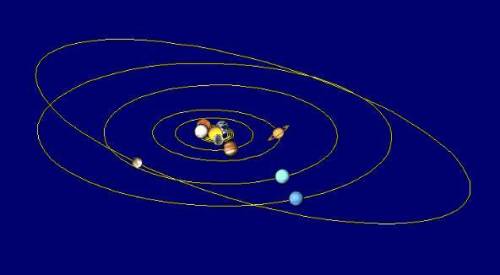Rotation of the Earth
The spinning of the Earth around its axis is called ‘rotation’. The axis...

Geography, 05.05.2020 14:07 lazavionadams81
Rotation of the Earth
The spinning of the Earth around its axis is called ‘rotation’. The axis has an angle of 23.5 degrees and is perpendicular to the plane of Earth’s orbit. Which means, Earth is tilted on its axis, and because of this tilt, the northern and southern hemispheres lean in a direction away from the Sun. The rotation of the Earth divides it into a lit-up half and a dark half, which gives rise to day and night. The Earth completes one rotation every 24 hours.
Revolution of the Earth
The movement of the Earth around the Sun in a fixed path is called a revolution. The Earth revolves from west to east in the counter-clockwise direction. The Earth completes one revolution around the Sun in one year or precisely in 365.242 days.
The revolution speed of the earth is 30 km per second.
Rotation and Revolution of Planets
Planets Mean distance from the Sun in millions of kilometres Period of Revolution Period of Rotation
Mercury 57.9 88 days 59 days
Venus 108.2 224.7 days 243 days
Earth 149.6 365.2 days 23 hr, 56 min, 4 sec
Mars 227.9 687 days 24 hr, 37 min
Jupiter 778.3 11.86 years 9 hr, 55 min, 30 sec
Saturn 1,427 29.46 years 10 hr, 40 min, 24 sec
Uranus 2,870 84 years 16.8 hours
Neptune 4,497 165 years 16 hr, 11 min
Difference Between Rotation and Revolution
The table given below provides the basic differences between the rotation and revolution.
Rotation Revolution
Rotation of the Earth is its turning on its axis. Revolution is the movement of the Earth around the Sun.
The Earth takes 24 hours to complete a rotation around the Sun. The Earth takes a full year (365 days) for one complete revolution around the Sun
The Earth’s axis of rotation is tilted by 23.5 degrees. This tilt causes the different seasons of the year. The path of the Earth moving around the Sun is called an orbit. The Earth’s orbit is elliptical.
Elliptical Orbits of Planets
All planet orbits including Earth are elliptical, which means they are an ellipse, similar to an oval. For some inner planets, the orbits are almost circular, but not quite. They are highly eccentric or "squashed." They look more like thin ellipses than circles. Satellites that orbit Earth, including the moon, do not always stay the same distance from Earth and also have elliptical orbits.
Please write a one (1) paragraph response to what you read, what you saw and what the video showed you.
video: https://youtu. be/l64YwNl1wr0


Answers: 2


Another question on Geography

Geography, 22.06.2019 07:00
What is the difference between external & internal migration
Answers: 1


Geography, 24.06.2019 03:30
Which is an accurate description of the physical characteristics of poland? its fertile soil is found only along riverbanks, and its mountainous region in the northwest has few mineral resources. it is mostly flat with fertile soil except in the east and northeast, and the mountainous region in the south has large deposits of coal and copper. it is covered with thick forests, and it has large reserves of coal, petroleum, and natural gas. its landscape is dominated by plateaus, mountains, and high ridges, and it has large deposits of sulfur and copper in the northeast.
Answers: 3

Geography, 25.06.2019 12:30
How has spanish colonization affected central america? a. english is now the primary language. c. the spanish forced people to become protestant. b. the region is still controlled by spain. d. many people are of mixed ancestry.
Answers: 1
You know the right answer?
Questions




Mathematics, 11.02.2021 01:00

English, 11.02.2021 01:00


Physics, 11.02.2021 01:00



Mathematics, 11.02.2021 01:00

Physics, 11.02.2021 01:00


Biology, 11.02.2021 01:00



History, 11.02.2021 01:00


Mathematics, 11.02.2021 01:00

Mathematics, 11.02.2021 01:00

Biology, 11.02.2021 01:00



